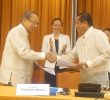
PEACE REPORTING. Dr. Crispin Maslog (2nd from left), lecturer at the Asian Institute of Journalism and Marco Mezzera (4th from left), senior advisor of the Norwegian Center for Conflict Resolution hand copies of the report, The Political Economy of the News Media in the Philippines and the Framing of News Stories on the GPH-CNN Peace Process to the representatives of the Office of the Presidential Adviser on the Peace Process on Tuesday, Dec. 6 at the Astoria Plaza in Pasig City. Also in photo (L-R): Helene Revhaug, senior communication adviser of NOREF, Mel Velarde, chairman of AIJC, Patricia Ruivivar, head of OPAPP Communications Group and Assistant Secretary Rolly Asuncion. (Zea Io Ming C. Capistrano/davaotoday.com)
PASIG CITY, Philippines – A recent report found that before the resumption of the peace talks between the government and the National Democratic of the Philippines this year, there was little interest from the media in reporting the peace process.
The study conducted by the Norwegian Centre for Conflict Resolution and the Asian Institute of Journalism and Communication revealed that last year, the GRP-NDF peace process “is invisible, with nothing going on worth reporting.”
A portion of the report reads: “The peace process as a news story does not resonate with the public and is not ‘sexy’ enough. Before the Mamasapano incident in January 2015 the Mindanao peace process was not interesting to media audiences, especially those living outside Mindanao.”
“As a result, there is currently very little media coverage of the peace process and no background coverage,” it said.
The report said the previous administration of President Benigno Aquino III appeared to focus more on the peace process with the Moro Islamic Liberation Front.
It noted that the “invisibility” of the peace process resulted to little media coverage.
During the forum where the report’s findings and recommendations were presented, Marco Mezzera, NOREF’s senior advisor told Davao Today they carried out the study in April last year at a time when the peace process was “frozen”.
The GRP-NDF peace process resumed in August this year following the declaration of President Rodrigo Duterte that he wants to achieve peace during his term.
Mezzera said “the Duterte factor carries a strong responsibility” in bringing back the interest of the media in the peace process.
“So by having him, betting a lot in the peace process in general, and making this also one of his central commitment during the election campaign I think it automatically raised a lot of interest across the society,” he said.
During the preliminary talks in June this year, Mezzera said there were about four to five media who covered. By August, there were seven different media outlets who sent 11 journalists to cover the first round of talks.
And by October, the number grew to 11 media outlets and 14 media representatives.
The report also said that given the bigger size of the audience from Metro Manila, there was limited coverage of the peace talks “because there is no market for the (Mindanao) peace story.”
It said that large audiences bring higher ratings and generate more advertising revenue to private media companies.
Conflict stories sell
Dr. Crispin Maslog, author of the report and senior consultant at the Asian Institute of Journalism and Communication said when reporting about peace negotiations, the media’s tendency is to report on the disagreement instead of the agreement “because it sells the newspaper and it sells the program.”
He described peace reporting as the opposite of conflict reporting, which the media is used to do.
“Kasi in conflict reporting merong asim, merong sex, it’s a sexy topic. Kung merong patayan, merong awayan, merong sagutan, if there’s conflict and therefore it’s sexy and therefore it attracts readers and ratings. Kaya ang media natin , being a commercial media, would like to have people watching the program or reading the newspaper (Conflict reporting has appeal, it has sex and it is a sexy topic. If there is crime, conflict, debate, if there’s conflict, therefore it’s sexy and it attracts readers and ratings. That’s why our media, being a commercial media, would like to have people watching the program or reading the newspaper),” he told Davao Today in an interview.
No context
It was also found out that most media coverage of the GRP-NDF peace process lacked context.
The report said the stories do not have “proper background” and were treated like crime stories.
“The news value that determines coverage is essentially conflict. Most reporting is spot news, such as NPA attacks, and there is no attempt at background reporting,” the report said.
The report also found out that news organizations do not devote more time and resources to produce an in-depth story. Reporting on the peace process is also affected by the daily story quotas expected of journalists to comply, according to the report.
Meanwhile, most information for the stories were obtained from the military press releases from government.
Aside from the lack of context, the report also found out that Philippine news media do not have regular reporters for the peace beat.
Those who were assigned to cover “are assigned to the defense beat, the presidential beat or the police beat.”
“These reporters do not have enough expertise to write contextual stories related to the spot news they cover,” it said.
Alternative media
Mezzera said the report came only now after they agreed on the revision and another section that defines the alternative media.
The report was published in September 2015 while the new edition came out on November 2016.
“The moment that the negotiations started in June, it was clear that besides the so-called mainstream media, there was a lot of engagement and interest from smaller media outlets that also tended to be, if I may say, more complete in terms of the analysis that they were putting out of the issues related to the peace process,” Mezzera said.
The report found out that because the alternative media are not owned or controlled by private corporations, the alternative media are “often able to fill the gaps left by the dominant media.”
Raymund Villanueva, director for radio of Kodao Productions, said they attempt to move away from the mainstream media’s treatment of news where the government is the official source of information.
“What’s official is what the people say… In that sense the alternative media contribute to the dynamism of Philippine journalism,” he said.
Villanueva added that unlike the reporters in mainstream media who are limited by the editors, the alternative media is not limited by the rules.
“In the dominant media you need to shorten your reports in order to give space for showbiz reports,” he said.
Villanueva admitted that alternative media is limited to release the story quickly, but he said this will not stop them from writing contextual stories.
“At least when a researcher puts it online, it’s there,” he said.
Kodao Productions covered the first and second round of the GRP-NDF talks in Oslo, Norway this year.
Media education
Maslog said the mass media should be educated on how to report the peace process.
“The peace process is a very important component of our national life and I think mass media should be educated enough to know how to report the peace process,” he said.
Mezzera added that it is important for journalists to report “as detailed, comprehensive way as possible about what is actually taking place in the negotiations instead of reporting formal statements.”
But while there is now an increasing interest from the media to report the peace process, Mezzera said it is important to understand “how the media can facilitate a wide and balance understanding of the next points of the agenda.”
The next substantial agenda of the peace process is the agreement on social and economic reforms, political and constitutional reforms and the end of hostilities and disposition of forces. The next round of talks is scheduled on the third week of January next year. (davaotoday.com)









